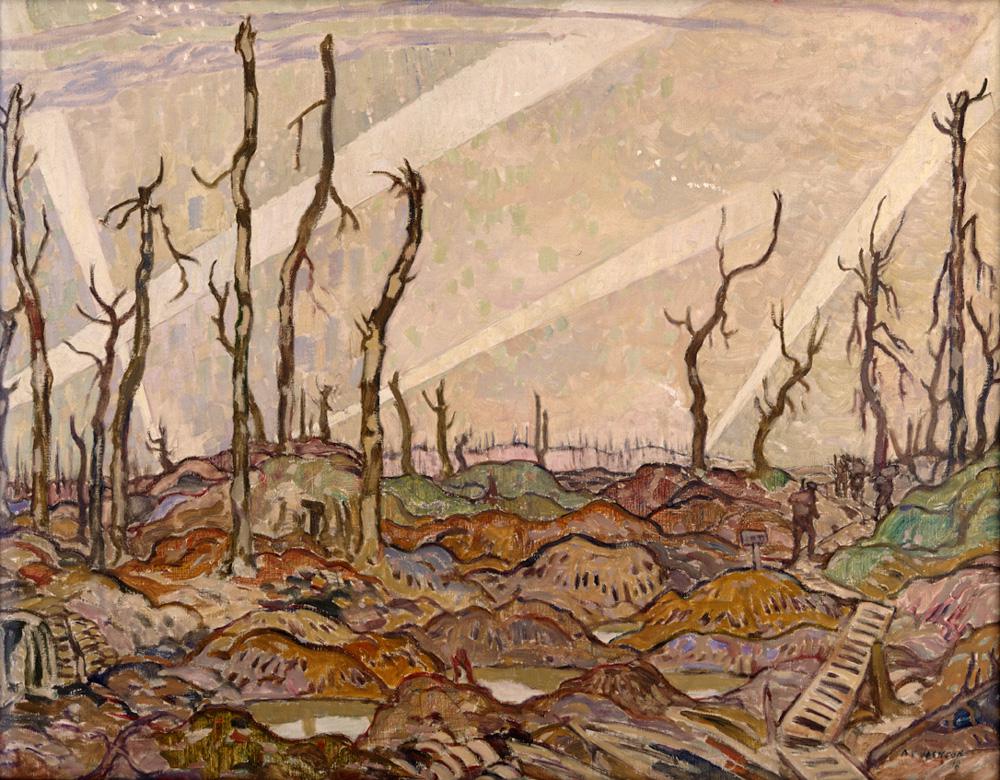The centenary of the Great War will herald many exhibitions for the period of 2014 to 2018. Curatorial strategies will vary: remembrance, commemoration, military history, freedom and sacrifice will all feature. But how many shows will offer something new—an original thesis or compelling perspective on how we recalibrate conflict? “Transformations: A.Y. Jackson & Otto Dix,” curated by Canadian War Museum historian Laura Brandon and currently on view at the Glenbow Museum, is one such show.
Most people associate Alexander Young Jackson with Canada’s iconic Group of Seven painters. Less well known is his fighting and injury in the First World War before becoming one of Canada’s first official war artists under Lord Beaverbrook’s War Memorials Fund. Arthur Lismer and F.H. Varley were also in the program, supporting Brandon’s argument that the Group of Seven was touched not just by the wilderness of Canada’s north; its visual language was also influenced by conflict. Thus, the Group of Seven’s association with a national visual identity is similarly conflict-related.
Brandon is not alone in questioning the foundations of the group’s practice. Beyond Wilderness: The Group of Seven, Canadian Identity, and Contemporary Art—edited by John O’Brian and Peter Whyte and released in 2007—also provides critical distance. But this show posits how Jackson’s specific experience in the war affected his concurrent and later landscape art, and it also compares and contrasts his experience with that of German artist Otto Dix, whose landscapes were impacted by wartime in a different way.
Dix might be best known for his large and colourful, yet dark, canvases portraying deformed veterans, prostitutes and societal struggle—but such works are largely absent here. That said, one image speaks to this aspect of Dix’s oeuvre: The Match Seller (1920) depicts a multiple amputee on the sidewalk being urinated on by a dachshund. Again, “Transformations” is more about landscape and how two artists took their practices in different directions in varied social contexts.
Brandon has compared the trajectories of these two artists to an X, with the point where the diagonals cross being the year 1933. At that time, the Group of Seven officially disbanded, and the Canadian Group of Painters formed and had its first exhibition—part of an upward career direction for Jackson. That same year in Germany, Hitler came to power and Dix was branded a degenerate artist; he was also fired from his teaching position at the Dresden Academy. One could read also this X symbol beyond referencing the paths of each artist; there is a parallel symbolic interpretation that Canada came from beneath and vanquished, while Germany’s repeated aspirations for empire fell to a subordinate position.
Through “Transformations,” Brandon’s scholarship claims several new stances.
One illuminating observation regards Jackson’s use of trees. Brandon points to British artist Paul Nash, known for his symbolic approach to landscape, as being a big influence on Jackson during the war: the splintered and shattered trees that populate Jackson’s wartime works could stand as sentinels for the dead. A Copse, Evening (1918) and Vimy Ridge from Souchez Valley (1918) are both striking examples of this. Jackson’s truncated and stylized trees were later adapted by other members of the Group of Seven (who, of course, were also influenced by Tom Thomson’s approach). These statuesque forms then morphed to represent growth, resilience and nature.
Brandon’s observations also extend to Walter Allward’s Vimy memorial and its possible connection to the Group of Seven’s visual language. She notes that the form of Allward’s monolith—for which design began in 1921 and which was unveiled in 1936—echoes the stump forms in Lawren Harris’s 1926 painting North Shore, Lake Superior, which the National Gallery describes as a “solitary tree, blasted smooth and clean by the forces of nature.” Recognizing that both Allward and members of the Group of Seven were members of Toronto’s Arts and Letters Club, she posits that a common visual language referencing war can develop yet be expressed in different forms.
Brandon’s re-evaluation of Dix’s little-known 1930 and 1940s landscapes is also notable. After being branded one of Hitler’s degenerate artists, Dix turned his brushes to Germany’s natural and farmed landscapes in what might even be considered a pseudo-naïve manner. Until now, these landscapes have been neglected compared to his earlier works. But Brandon highlights the consistent incorporation of ominous constituents: funerary processions, storms, withered trees and even cracked surfaces, all undermining the notion of a secure national identity.
Some of these Dix works have never left Germany, yet the lenders agreed to the loans because of this show’s significance. I concur, adding arguments that go beyond the parallels to Jackson. Such renderings are a precursor to the redemptive practices contesting national identity for which Anselm Kiefer’s later paintings are normally referenced. Additionally, although these Dix canvases are little known in North America, I see a resemblance to the Hudson River School, and recall Kent Monkman’s more recent appropriations toward aims of repainting justice: paintings that come to mind in this respect are Dix’s Thunderstorm over Randegg (1934), and Fog (Schrammsteine) (1938)
In conclusion, visitors may find the large text panels overbearing, but this is essentially a major bilingual historical exhibit—next stop the Canadian War Museum, opening April 2014. There is clearly new content for all audiences and perhaps of most value is Brandon’s aim to highlight the relevance of war art not just historically, but also now. I can add that the Canadian Forces Artists Program still affords opportunities for contemporary war artists: the next deadline for applications is November 30, 2013.









